Clay Plager-Unger
Field Projects Manager
Planet Drum Foundation
July, 2012
The dry season weather has set in solidly during the past month. Temperatures have dipped a tad, it’s a little windier and there tends to be more overcast days. The weather is very comfortable for working outdoors – even though when the sun comes out around midday it still scorches. And one of the best parts: the drier, cooler weather means fewer mosquitoes!

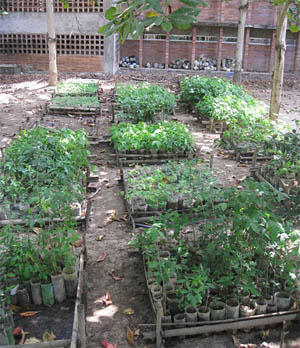
Since more definitive computer model predictions were released in early July, local media outlets have been publicizing that this year might see a return of El Niño. Current NOAA and other NINO34 computer models are predicting moderate El Niño conditions, even though it’s still a little early to know for sure. These computer models have difficulty predicting with high degrees of accuracy beyond three months. El Niño effects usually begin around December, hence the name (El Niño – the child – i.e. Jesus).
In 1998, Sea Surface Temperatures (SST) anomalies (changes in ocean temperature in degrees Celsius) for the NINO34 region reached 2.69 (actually in December 1997). In 1982, the El Niño phenomenon previous to 1998 that caused major damage in the region, SST anomalies for NINO34 reached 2.79. [http://www.cpc.ncep.noaa.gov/data/indices/sstoi.indices]
What the local media fails to realize is that nearly every year SST anomalies reach levels that scientists define as either El Niño (0.5ºC above average) or La Niña (0.5ºC below average) conditions. The mean SST anomalies for an ensemble of computer models for now (July 2012) through March 2013 hover around 0.8ºC above average. [http://www.bom.gov.au/climate/poama2.4/poama.shtml#indiceTitle]
In summary, SST anomalies are predicted to remain solidly in El Niño territory from now through at least next March and we will be experiencing El Niño related weather patterns.
Do local Bahia (and Ecuador) residents need to fear a repeat of the disasters that resulted due to the heavy rains in 1982 and March 1998? It may still be too early to tell, but current computer models suggest that an intense El Niño phenomenon is unlikely. Regardless, El Niño and La Niña are cyclical weather patterns and it is only a matter of time before peaks in these cycles result in extreme weather.
Also interesting to note, which I mentioned in my previous report, is that this past rainy season (January through April) saw more precipitation in the region than during the 1998 El Niño phenomenon. Additionally, the mudslides that devastated the region in 1998 occurred after only two weeks of torrential rains! Visible records of this devastation (mostly in the form of erosion) are abundant in and around Bahia. The effect on the psyche of the population is visible through the nervousness in which local residents absorb the recent news about the potential another El Niño this year.
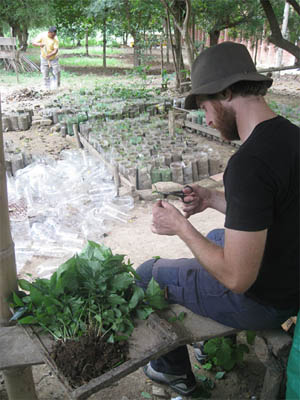
Now, what is one of the best methods for controlling erosion and limiting extreme weather patterns in the long term? That’s right, revegetation!

This past month, we’ve been working intensely at the greenhouse. Several seedbeds were bursting with seedlings that needed transplanting. Hundreds of Ebano, Guachepeli and Pechiche were transplanted from the beds into plastic bottles.

In preparation for the upcoming rainy/planting season, we’ve been collecting, prepping and planting more seeds. Tierramonte seeds were collected, as were Algarrobo and Dormilon. Beds for these seeds were created at the greenhouse and the seeds were planted for germinating.




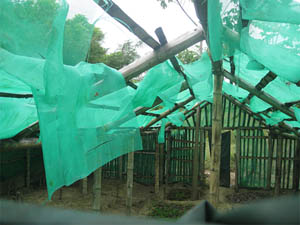


Also, we’ve begun working on what will be a major renovation of the greenhouse structure, which has served us well for over six years, but has been in an increasing state of disrepair. As such, nearly all of the bamboo will be replaced. The roof will be raised a bit to avoid the frequent head bumps that plagued the old greenhouse. Also, the roof material (previously green plastic) will be replaced with much more natural palm fronds.

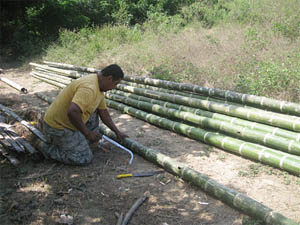
This is a good time to be working on the greenhouse, because it is entirely empty, except for the seed beds. Once construction is completed we will be able to start filling it up with new trees.
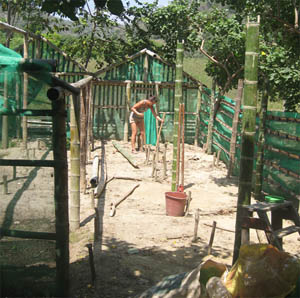

So far, two truckloads of bamboo have been delivered and we have dismantled one half of the greenhouse. We are trying to keep the walls intact, where the green mesh still has a bit more life in it and won’t be replaced. Nearly all of the bamboo will be replaced. Some of the most damaged pieces of bamboo were already replaced last year.
We have also been doing major cleaning up of the grounds around the greenhouse, including burning some brush and weeds, which grow too quickly and compost too slowly and all the while create habitat for critters we aren’t interested in having around the greenhouse, such as snakes.
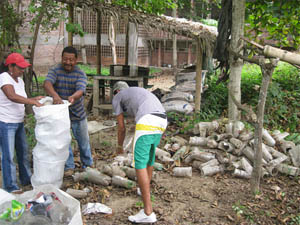
We also had our first (at least in the five plus years that I’ve been with Planet Drum) Ecuadorian volunteer who stayed at the house—as opposed to day volunteers, of whom we’ve had many, of course. His name is Shubert, from Manta, and he spent three weeks, so far, working with us. One of Shubert’s motivations for volunteering with Planet Drum in Bahía was to be able to connect with the Bellavista neighborhood so that he can possibly set up a project with them related to healthcare through a local university system. Shubert helps us with our ecological projects in the mornings and during the afternoons develops his project with Bellavista. The necessary contacts were made and we are waiting to see if we will be able to take the next step, which is to introduce all of the parties involved and see if it will be possible to proceed with the project. More information on this as it develops.

One last piece of work that we’ve done during the past month has been the commencement of watering the revegetation sites that were planted this past rainy season. We watered the site at El Bosque en Medio de las Ruinas. The trees are looking very healthy, but they clearly were happy to get a drink. I would estimate a survival rate of over 80%, which is great. Three other sites, at El Toro, Universidad Catolica and Dr. Parra, will all also need water in the coming weeks.

Pásalo bien,
Clay

Your article helped me a lot, is there any more related content? Thanks!